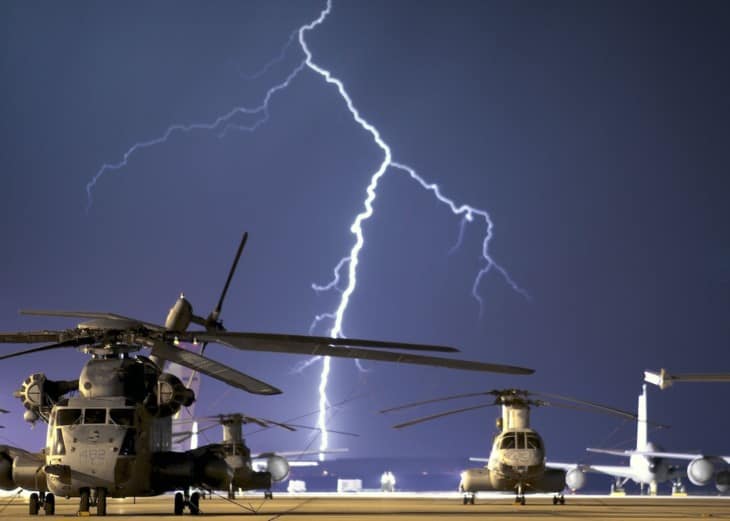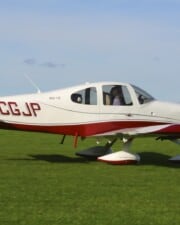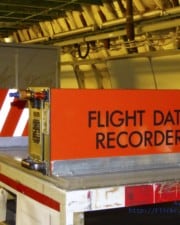Lightning is one of the most potent forces of nature. It is seemingly random, a powerful act of God that shakes you in your boots. Everyone knows not to be playing golf in a thunderstorm because metal and tall objects attract lightning. But what about airplanes? They’re made of metal and flying in the clouds!
Pilots don’t do anything special to avoid lightning strikes. Most airplanes, including all large transport category aircraft, are designed to withstand a lightning strike safely. As unpredictable and destructive as lightning is, it is well understood by engineers. Some experts believe that every airplane is struck on average at least once a year. Of course, there are times when lightning causes damage to the aircraft’s outer skin that needs repair.
What is Lightning?
Have you ever walked across the carpet and gotten zapped by static electric when you touched the doorknob? If you have, you’ve been struck by lightning, albeit on a tiny scale.
Lightning results from a sudden and powerful discharge of static electricity in the atmosphere. As air moves in the atmosphere, it builds up an electric charge dissimilar from that of the ground (cloud-to-ground lightning), or even areas of sky nearby (cloud-to-cloud lightning).
It occurs when there is a lot of movement in the atmosphere, specifically convection. Therefore, it’s nearly always associated with thunderstorms. But other atmospheric conditions can cause lightning as well, such as volcanic eruptions or intense forest fires.
Airplanes are at particular risk from lightning strikes since they build up a static charge of their own as the air flows over their skins. Part of how airplanes avoid lightning strikes comes from dissipating any amount of charge built up on the airframe. To accomplish this, many planes have static dissipators, also known as static wicks, on the trailing edges of their wings and tail.
For more information about lightning, including some cool graphics showing the exotic types of lightning that exists above the clouds, check out NOAA’s Severe Weather 101 page.
Aircraft Lightning Protection
According to Scientific American, the last airline crash directly attributed to a lightning strike was back in 1967. On that flight, the electrical discharge caused the fuel tanks to explode. Research and stricter requirements in the design and building of transport planes have vastly improved safety since then. Modern designs must demonstrate the ability to take lightning strikes safely.
Metal Airplanes
Metal airplane structures conduct electricity. When lightning strikes, it will often hit a wingtip, then move through the aircraft’s outer skin towards the opposite charge as it dissipates, usually exiting the plane at the tail. As long as the current continues uninterrupted, it shouldn’t harm the aircraft.

Planes are designed to maximize this effect. Most lightning protection systems installed consist mostly of a system of metal plates, wires, and tubes that connect every part of the aircraft together electrically. This way, no matter where the lightning comes in, it can be directed through the plane and discharged safely. As long as there are no breaks in the system, designers can be confident that lightning will be conducted correctly.
Of course, planes are full of a host of things that don’t get along well with uncontrolled and powerful electric discharges. Fuel, sensitive electronics, and human bodies come to mind. To protect those items, they must remain insulated from the metal frame of the aircraft.
All parts of the fuel tanks and fuel system are overdesigned and tested to withstand the worst-case lightning strike scenario.
Composite Aircraft
A whole new set of problems occurs with composite aircraft. Manufacturers are using more and more composites in their designs to create more efficient airframes. But composites like GFRP (glass-fiber-reinforced plastic) and CFRP (carbon-fiber-reinforced plastic) don’t conduct electricity well. Carbon fiber, specifically, can come apart if lightning weakens its structure.
These airplanes need to have even more advanced lightning systems. For small areas of composites, like radomes, lightning deflector strips can be used. These are small bits of metal that “catch” the electrify from a strike and divert it into the primary lightning system.
Airplanes like the new Boeing 787, which have mostly composite airframes, have to have integrated systems to capture and disperse lightning strikes. As approved by the FAA, the original system had a metal fastener sealed into the wing structures, which was bonded to strips of copper foil on the outer skin to disperse strikes. The Seattle Times has reported that Boeing has made some changes to the system throughout production that may not have been FAA-approved.
What Happens When Lightning Strikes an Airplane
Inside the plane, a lightning strike may not be noticeable at all. Some pilots report that the lights may flicker, or they may receive interference in the radios for a few moments. The fuselage in metal airplanes acts as a faraday cage, which insulates the occupants and electronics from any damage.

While the plane is designed to handle it, lightning strikes are not considered “normal operations.” Abnormal operations are things that can be done, but special care must be taken. Besides lightning strikes, things like overweight landings or hard landings are examples of abnormal operations.
Most planes and airlines require some form of inspection after a lightning strike occurs. Generally, there is no damage, but occasionally some repairs to the aircraft’s skin may be required.

Lightning and Small Airplanes
It’s important to note that complicated systems and lightning certification requirements exist for transport category aircraft. When discussing smaller general aviation planes, chances are they come with no such assurances.
Why would the FAA not require these systems to the same level on smaller airplanes? For the simple reason that these planes are far less likely to be flying near thunderstorms anyway.
Thunderstorms contain many hazards to aircraft, but airliners and cargo planes are large enough to handle all but the worst of them. On the other hand, small planes are easily jostled by wind shear and more susceptible to damage.
If a thunderstorm exists, it contains severe wind shear. It may also contain sudden downdrafts like microbursts, gusty conditions near the ground, hail, tornadoes, severe icing, and violent turbulence. For these reasons and more, small airplanes must steer clear of thunderstorms at all times.
When arriving and departing airports, planes can hold until the storm has moved on. While flying en route, pilots can usually deviate a few degrees off their course and safely avoid storms.
Related Posts














